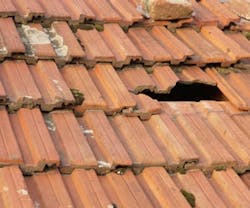Lifecycle claims and sustainability issues continue to hit the front pages of roofing journals. You may have noticed that EPDM rubber roofs, for example, have been around for more than 50 years and bituminous built-up roofing has lasted more than a century. Roof warranties are getting longer and longer, implying that roof systems are better than ever.
Many of you are not getting 50 trouble-free years – in fact, you may not even achieve the 20-year gold standard. The intent of this column is to assure you that you are not the only reader with that queasy feeling.
The Root of Failure
It is not that our roofs are not as durable as claimed. Many of those 20-year warranties had all sorts of exclusions, with the major ones being abuse and neglect as well as limited bond sums. That will only get worse, as we are now seeing solar panels being installed directly over existing low slope membranes and more equipment being placed on rooftops, for example.
Traffic on our membrane systems is an ongoing problem, whether from our in-house personnel or outside contractors. Neglect, such as not keeping debris out of the drains, is also a continuous issue.
The literature encourages us to make at least two visual inspections of our roof systems: “when the ducks fly north and when they fly south.” It is also recommended whenever there has been construction traffic on the roof or immediately after experiencing severe weather.
To achieve the stated longevity, we need to make two important decisions: between an in-house or outside roof expert and a contractor vs. a consultant. This month, let’s examine what a successful in-house program looks like.PageBreak
How to Build an In-House Roof Maintenance Program
Richard (Dick) L. Fricklas was technical director emeritus of the Roofing Industry Educational Institute prior to his retirement. He is co-author of The Manual of Low Slope Roofing Systems, and continues to participate in seminars for the University of Wisconsin and RCI Inc., the Institute of Roofing, Waterproofing, and Building Envelope Professionals. His honors include the Outstanding Educator Award from RCI, William C. Cullen Award and Walter C. Voss Award from ASTM, the J. A. Piper Award from NRCA, and the James Q. McCawley Award from the MRCA. Dick holds honorary memberships in both ASTM and RCI Inc.
The first step is to have an up-to-date roofing file on every section of every roof that you are responsible for. That file should represent the actual as-built systems, plus documentation of previous repairs, copies of roof warranties, and a current address or phone number for the supplier of each membrane roof in case a problem arises.Designate someone on your staff as the official point person for all roofing issues. If no such skilled person is currently available, at least one person should accept such responsibilities, with a commitment from corporate to get this person trained in every type of roof system under your control. That could include attending roofing seminars and conventions and even hands-on seminars now offered by most manufacturers.
When that inevitable leak occurs, objectives shift to having adequate tools and materials to at least make temporary repairs. An emergency repair, such as one located directly over a critical process, could be almost anything. Duct tape has worked on small punctures, at least for 24 hours. Torched-on modified bitumen patches work well if the substrate is reasonably clean and dry. (The torch will evaporate surface water and help bituminous surfaces bleed to engulf dirt and debris.) Bottles of propane must be properly stored, and fire extinguishers need to be on the roof if torching is being done.
Many of the single ply systems have a limited shelf life, especially the sealants and mastics. While fibrated asphalt mastic can be obtained at most any big box building supply house, date codes need to be checked for more sophisticated elastomerics.
While our point person may be managing the roofing plan, trained laborers will do the actual hands-on repairs. A roof in trouble is no place for an unescorted worker. If there is ice or water on the roof following severe weather, safety is paramount.
Many material manufacturers will come to your facility and demonstrate various repairs to train your workers. An important resource for them is the Repair Manual for Low-slope Membrane Roof Systems, a joint publication of the National Roofing Contractors Association (NRCA), Asphalt Roofing Manufacturers Association (ARMA), and Single Ply Sheet Membrane and Component Suppliers (SPRI).
Another helpful resource is GAF’s recommended schedule of inspections and repairs.
In a future column, we will look at alternatives to in-house programs, including using roofing consultants and establishing service contracts with responsible local contractors.
TPO Repair Tips
A repair mistake today could cost you tomorrow.
Green Roofs and the Urban Heat Island Effect
The heating phenomenon in cities doesn’t just increase cooling needs – it contributes to increased air pollution and water consumption and negatively impacts local economies.
Stop Leaks in Their Tracks with a Dependable Air Barrier
Up to 40% of a building’s energy costs for heating and cooling are wasted by uncontrolled leaks.
About the Author
Richard L. Fricklas
Richard (Dick) L. Fricklas received a Lifetime Achievement Award and fellowship from RCI in 2014 in recognition of his contributions to educating three generations of roofing professionals. A researcher, author, journalist, and educator, Fricklas retired as technical director emeritus of the Roofing Industry Educational Institute in 1996. He is co-author of The Manual of Low Slope Roofing Systems (now in its fourth edition) and taught roofing seminars at the University of Wisconsin, in addition to helping develop RCI curricula. His honors include the Outstanding Educator Award from RCI, William C. Cullen Award and Walter C. Voss Award from ASTM, the J. A. Piper Award from NRCA, and the James Q. McCawley Award from the MRCA. Dick holds honorary memberships in both ASTM and RCI Inc.

